Blue whales and orcas may share a common home, but their lifestyles, behaviors, and physical attributes contrast markedly.
Blue whales, the largest animals on Earth, predominantly eat tiny crustaceans called krill. In contrast, orcas, or killer whales, have a more varied diet, including seals, sea lions, and even other whales. Furthermore, while orcas exhibit distinct black-and-white patterns, blue whales have a mottled blue-gray color.
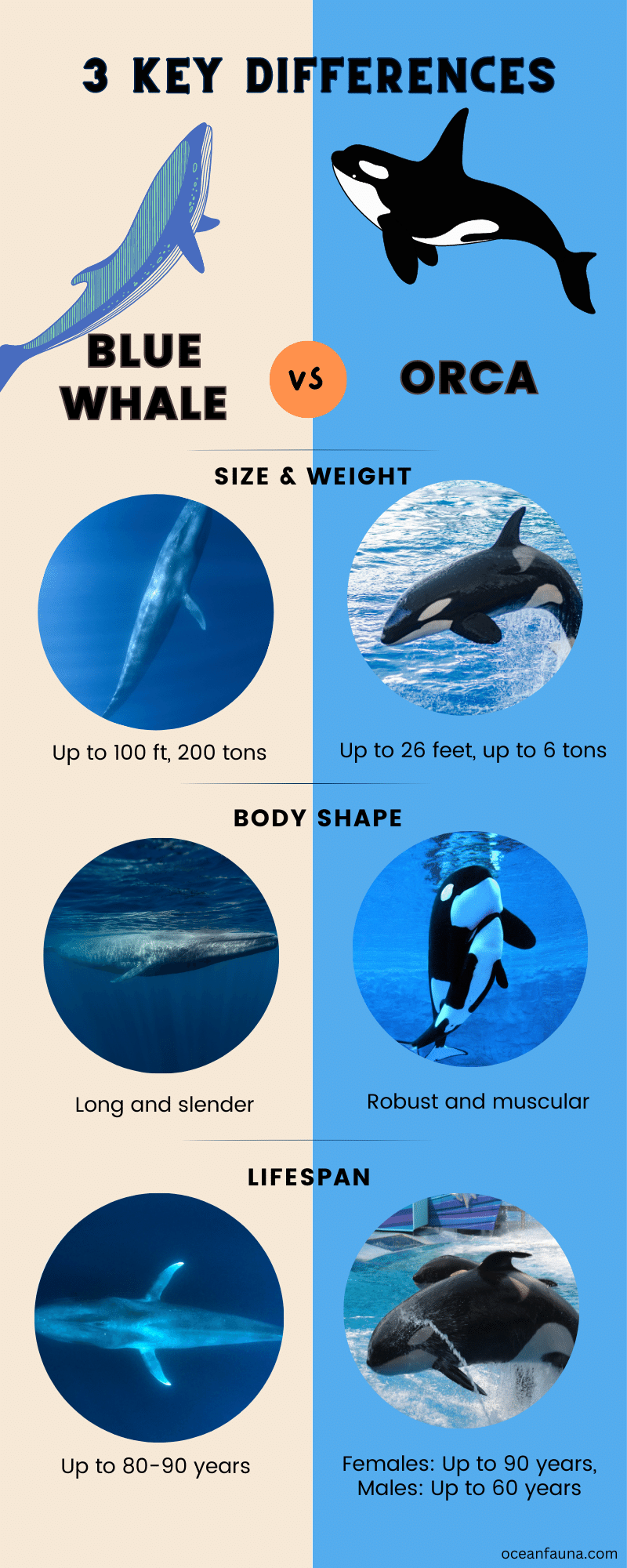
The marine world, filled with life of all sizes, presents us with creatures as diverse as the blue whale and the orca. Even though they both live in the water, they’re like the apples and oranges of the sea world. They have their own unique adaptations, which help them live and thrive in their watery home.
Did you know blue whales are solitary creatures, unlike orcas which live in complex, social groups called pods?
Curious to learn more about their fascinating distinctions?
Join us on this exploration to understand more about the uniqueness of blue eagles and orcas and the secrets they hold. There’s so much more beneath the surface, and it’s high time we uncovered it together.
Blue Whale vs Orca – A Quick Comparison
Let’s quickly look at the differences between these two marine giants.
| Feature | Blue Whale | Orca |
| Scientific name | Balaenoptera musculus | Orcinus orca |
| Family | Balaenopteridae | Delphinidae |
| Body Shape | Long and slender | Robust and muscular |
| Size | Up to 100 feet long, weighing up to 200 tons | Up to 26 feet long, weighing up to 6 tons |
| Diet | Primarily krill | Diverse (fish, marine mammals, other whales) |
| Habitat | Global distribution (except the Arctic), open oceans | Global distribution, various habitats (open seas, coastal waters, semi-enclosed bodies of water) |
| Social Behavior | Solitary or small groups | Matriarchal pods |
| Lifespan | 80-90 years (some over 100) | Females: Up to 90 years, Males: Up to 60 years |
| Gestation Period | 11-12 months, a single calf born | At approximately 17 months, a single calf born |
| Defense Mechanisms | Speed, deep diving, tail, and sheer size | Group defense strategies, intelligence, echolocation, massive size. |
| Interaction With Humans | Historical whaling, whale-watching, scientific research | Cultural significance, capture for marine parks, whale-watching, scientific research |
| Threats | Ship strikes, entanglement, climate change, noise pollution | Pollution, prey depletion, noise pollution, habitat disturbance, capture for marine parks |
| Conservation Status | Endangered (IUCN) | Data Deficient |
Blue Whale vs Orca – What Are the Key Differences?
Blue whales and orcas, both warm-blooded mammals, have their home in the ocean. They have lungs for breathing, and even a layer of blubber, just like a winter coat, to keep them warm in the chilly waters. They’re super swimmers with bodies built for speed and the ability to dive deep into the sea.
But despite these similarities, they’re quite different from each other. Ready to find out how? Let’s look closer and discover what makes these two sea giants unique.
1. Taxonomy and Scientific Classification
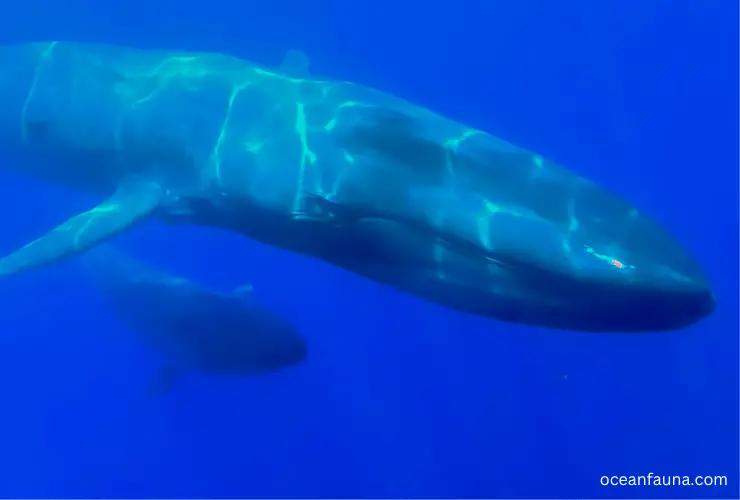
Blue whales and orcas belong to the class Mammalia and the order Cetacea, which includes all whales, dolphins, and porpoises. Despite these shared classifications, they diverge significantly at the family and species levels.
Blue Whale
The blue whale (Balaenoptera musculus) is part of the family Balaenopteridae, commonly known as the Rorqual family. This family includes other large species, such as humpback and fin whales.
Blue whales fall under the Mysticeti (baleen whales) sub-order, distinguished by baleen —a system of filter-feeding plates in place of teeth.
Five recognized sub-species of the blue whale can be found in various marine environments across the globe, including
- The Northern blue whale, B. m. musculus.
- The Antarctic blue whale, B. m. intermedia.
- The Northern Indian Ocean blue whale, B. m. indica.
- The Pygmy blue whale, B. m. brevicauda.
- The Chilean blue whale
Orca
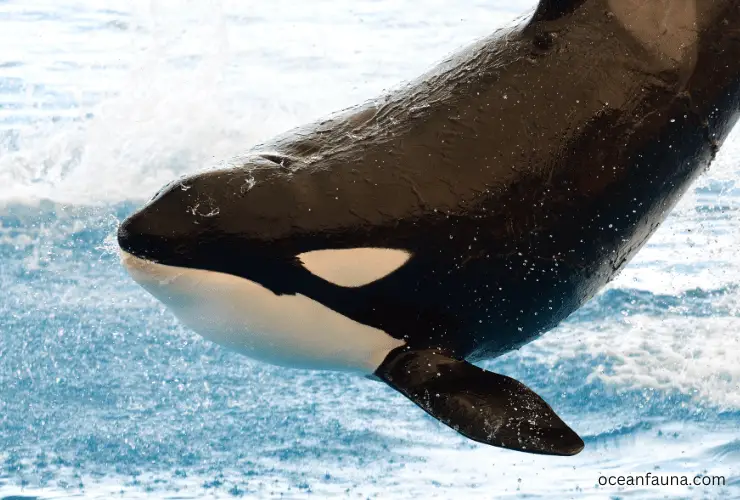
On the other hand, the orca (Orcinus orca) belongs to the family Delphinidae, the dolphin family, making it the largest dolphin species. Yes, that’s right, orcas are technically a type of dolphin!
They are a part of the Odontoceti (toothed whales) sub-order, characterized by having teeth and typically a single blow hole.
| Taxonomic Rank | Blue Whale | Orca |
| Class | Mammalia | Mammalia |
| Order | Cetacea | Cetacea |
| Suborder | Mysticeti | Odontoceti |
| Family | Balaenopteridae | Delphinidae |
| Genus | Balaenoptera | Orcinus |
| Species | B. musculus | O. orca |
2. Habitat and Distribution
Blue whales and orcas occupy different habitats and have distinct distributions throughout the world’s oceans.
Blue Whale
Blue whales are truly global animals found in all the world’s oceans except the Arctic, with a distribution dictated largely by the availability of their preferred food: krill.
They also don’t appear in specific regional waters like the Mediterranean, Okhotsk, or Bering seas. Sightings are also particularly rare along the eastern coasts of South America and Australia. ~ Source
Though blue whales traverse vast ocean expanses, it’s not always easy to encounter them. This is primarily due to two reasons.
Also Read: Blue Whale vs Whale Shark: Differences and Battle Winner
- Firstly, their numbers have sadly dwindled over time, which makes sightings less common.
- Secondly, they typically prefer the open sea, staying away from coasts except in a handful of known areas where they come to breed and feed.
They migrate seasonally, spending summers feeding in high-latitude, nutrient-rich waters and winters in more temperate, low-latitude waters for breeding, as detailed by National Oceanic and Atmospheric Administration.
Specific populations, such as the Pygmy blue whale, have a more limited range in the Southern Hemisphere, constituting the Indian Ocean.
Orca
Contrastingly, orcas have the most widespread distribution of any marine mammal, found from the polar regions to the Equator. They are more plentiful in cold oceans like Antarctica, Norway, and Alaska. However, they also inhabit tropical and subtropical waters, as documented by National Oceanic and Atmospheric Administration.
They occupy a variety of marine environments, including open seas, coastal waters, and even semi-enclosed bodies of water.
The presence of their diverse prey influences their distribution. Resident populations, such as the Pacific Northwest’s Southern Resident Killer Whales, have smaller, more localized ranges, primarily due to specific diet preferences.
| Feature | Blue Whale | Orca |
| Global Distribution | Yes (except the Arctic) | Yes (most widespread marine mammal) |
| Habitats | Open oceans | Open seas, coastal waters, semi-enclosed bodies of water |
| Migration | Yes (seasonal) | Variable (depends on population) |
| Distribution Influence | Availability of krill | Availability of diverse prey |
3. Physical Appearance
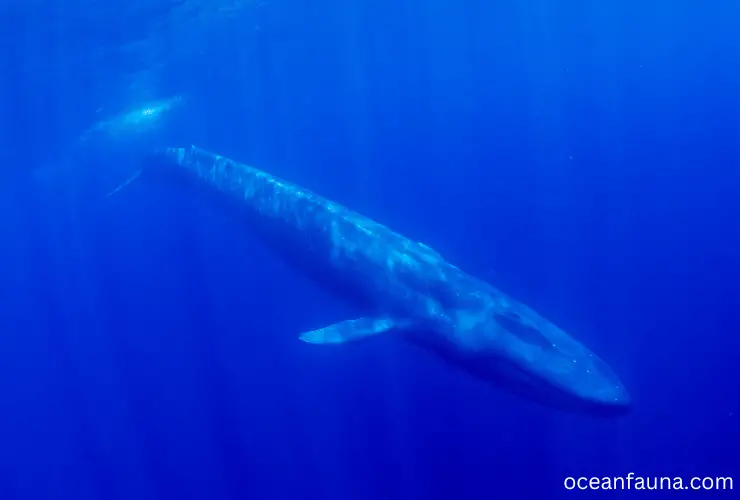
Blue whales and orcas have distinct physical characteristics that set them apart, with adaptations suited to their specific lifestyle and habitat.
Blue whale
- Body size and weight: The blue whale can reach lengths up to 100 feet and weigh as much as 200 tons.
- Body shape: Their long and slender bodies give them a streamlined shape for efficient swimming.
- Coloration: They display a mottled blue-gray color, lighter on the underside.
- Teeth: Blue whales are characterized by their broad, flat rostrum and baleen plates for filter feeding.
- Dorsal fin: They have a tiny dorsal fin set far back on their bodies.
- Tail flukes: They have a thick tail stock with massive flukes and smooth trailing edges.
Orca

- Body size and weight: On the other hand, orcas are much smaller, averaging 20-26 feet long and weighing almost 6 tons.
- Body shape: They have a more robust and muscular body, with a rounded head that tapers to a point.
- Coloration: They feature a distinct black-and-white coloration, with a white patch that goes up their bellies.
- Dorsal fin: Orcas feature a large dorsal fin (especially prominent in males), reaching up to 6 feet tall.
- Teeth: Unlike the blue whale, orcas have a set of sharp teeth, crucial for their varied diet.
- Flippers: Orcas have large, wide paddle-shaped flippers.
- Tail flukes: Their tail flukes are black on top and pale below. ~ Source
Did you know? Orcas are born with one blowhole (unlike the blue whale, which has two blowholes).
| Feature | Blue Whale | Orca |
| Length | Up to 100 feet | 20-26 feet |
| Weight | Up to 200 tons | Up to 6 tons |
| Body Shape | Long and slender | Robust and muscular |
| Coloration | Mottled blue-gray, lighter underneath | Black and white |
| Dorsal Fin | Small, set far back on the body | Large and prominent |
| Blow holes | Two | One |
4. Diet and Feeding Habits
Blue whales and orcas have very different diets and feeding habits dictated by their physical attributes and the ecosystems they inhabit.
Blue whale
Blue whales mainly consume teeny shrimp-like animals known as krill. They are baleen whales equipped with comb-like plates instead of teeth, allowing them to filter feed.
During feeding seasons, a blue whale consumes up to 4 tons of krill daily, according to the American Cetacean Society! This means it can consume approximately 40 million krill per day.
Orca
In contrast, orcas have a diverse diet, making them apex predators of the ocean, as detailed in the book Ethology and Behavioral Ecology of Odontocetes. They are equipped with sharp teeth, allowing them to hunt a variety of prey, including
- Fish
- Birds
- Rare beaked whales
- Seals
- Sharks
- Other dolphins.
Based on their diet and age, orcas can eat around 10 percent of their body weight daily.
| Feature | Blue Whale | Orca |
| Diet | Krill (primarily) | Diverse (fish, marine mammals, other whales) |
| Feeding Mechanism | Baleen plates for filter feeding | Sharp teeth for predation |
| Daily Food Intake | Up to 4 tons of krill | Up to 10% of their body weight |
| Hunting Strategy | Filter feeding | Complex group hunting strategies |
5. Social Behavior
Blue whales and orcas exhibit significant differences in social behavior, shaped by their unique lifestyles and ecological roles.
Blue whale
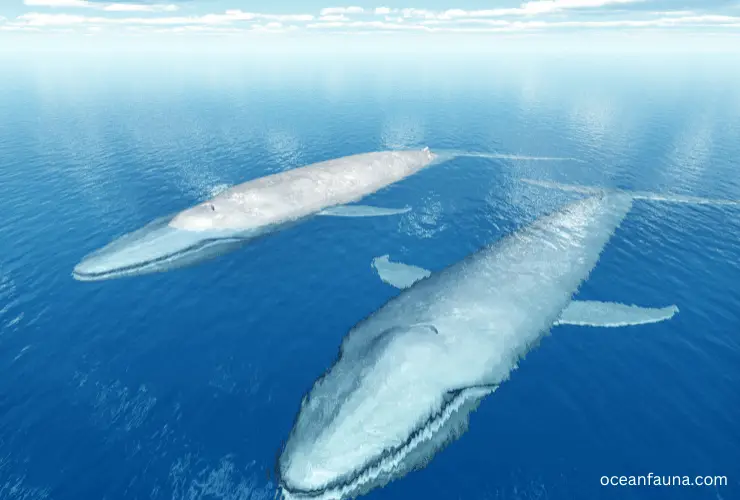
Blue whales are largely solitary animals or travel in small groups, usually in pairs. They communicate through a series of low-frequency pulses, groans, and moans, which can be heard over long distances. These sounds are thought to serve multiple purposes, including navigation, locating food, and finding mates.
Orca
Conversely, orcas live in highly structured, matriarchal social groups called pods. These can range from just a few individuals to larger groups of 50 or more.
Their complex social structure is accompanied by a diverse array of vocalizations used for communication and echolocation. Moreover, different orca populations exhibit unique cultures, reflected in specific hunting techniques and vocal patterns.
Some common behaviors shown by orcas include
- Breaching (the act of the orca jumping out of the water and splashing the surface with its entire body).
- Tail flapping (whereby the orca slaps the water surface with the fluke)
- Spy–hopping (orca keeping itself vertical in the water and kicking with its tail to hold its head above the water surface).
- Rubbing on rocks to remove dead skin cells.
| Feature | Blue Whale | Orca |
| Group Structure | Solitary or small groups | Matriarchal pods of 50+ individuals |
| Communication | Low-frequency pulses, groans, and moans | Diverse vocalizations |
| Culture | Not observed | Distinct among different populations |
6. Reproduction and Lifecycle
Blue whales and orcas have different reproductive strategies and life cycles, reflecting their adaptations to survive and thrive in their respective ecological niches.
Blue whale
- Sexual maturity: Blue whales typically reach sexual maturity between 5 to 15 years.
- Gestation period: They have a gestation period of about 10-12 months, after which a single calf is born.
- Nursing: The calf is nursed for approximately 6-7 months and can consume up to 150 gallons of its mother’s milk daily.
- Lifespan: Blue whales can live up to 70-90 years, though some have been known to live over 100 years.
Orca
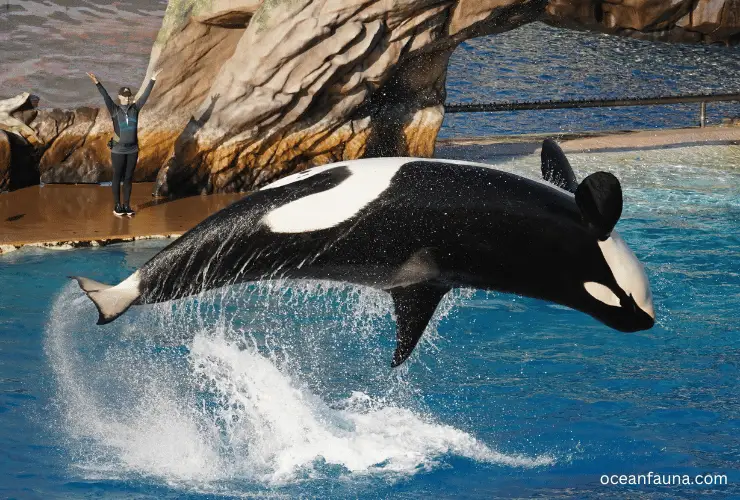
- Sexual maturity: On the other hand, Orcas reach sexual maturity at around 10 years for males and 12-14 years for females.
- Gestation period: Their gestation period is around 15 to 18 months, one of the longest marine mammals.
- Nursing: Orca calves are nursed for up to 2 years but may stay with their mothers usually until the arrival of a sibling, which takes place about 5 years after their own birth.
- Lifespan: Orcas have a similar lifespan to blue whales, with females often living into their 90s and males typically living up to 50 years.
Did you know? A female killer whale, on average, will have 5 calves over 25 years. Following this period, they enter a stage where they no longer bear offspring. However, they maintain a significant role within the pod, often acting as caregivers to the calves of other females.
This post-reproductive stage in female killer whales is a rare phenomenon among mammals. In fact, apart from humans, these are the only known mammal species where females experience an extended post-reproductive period (menopause).
| Feature | Blue Whale | Orca |
| Sexual Maturity | 5-15 years | Males: 10 years, Females: 12-14 years |
| Gestation Period | 10-12 months | 15 to 18 months |
| Offspring | Single calf | Single calf |
| Weaning Period | 6-7 months | Up to 2 years |
| Lifespan | 70-90 years (some over 100) | Females: Up to 90 years, Males: Up to 50 years |
7. Natural Predators
Blue whales and orcas, due to their size and strength, sit atop the marine food chain, limiting the number of natural predators they face.
Blue whale
Blue whales, given their enormous size, have few natural predators. However, they are not entirely safe, as orcas have been known to attack young or weak blue whales in coordinated efforts.
Orca
Orcas are apex predators, meaning they are at the topmost part of the food chain. This gives them a unique ecological role as they have no natural predators in the wild.
| Species | Natural Predators |
| Blue Whale | Orcas (rarely, usually young or weak individuals) |
| Orca | None (Apex Predator) |
8. Defense Mechanism
Blue whales and orcas possess distinct defense mechanisms that help them survive in their marine environments.
Blue whale
Blue whales have few natural predators due to their immense size, making physical defense mechanisms less crucial.
When threatened, a blue whale’s primary defense is to use its strong tail for diving deep and escaping from danger. Their size alone is a formidable deterrent, but speed and deep diving are their best protection against persistent predators like packs of orcas.
They can reach speeds of about 35 km/h when in danger, but they typically cruise around at about 20 km/h.
Orca
On the other hand, Orcas are apex predators without any natural predators. Their defense mechanisms are more related to their social structure and intelligence. Their brain is almost four times that of our brain, weighing almost 7 kg.
Orcas live in close-knit groups and employ collective defense strategies when faced with threats. For example, they have been observed forming protective circles around weaker members when threatened.
Did you know? Orcas can swim at remarkable speeds of around 56 kilometers per hour, making them one of the fastest marine mammals, as documented in the International Journal of Avian & Wildlife Biology.
| Species | Defense Mechanisms |
| Blue Whale | Speed, deep diving, sheer size |
| Orca | Speed, group defense strategies, high intelligence, hunting techniques |
9. Interaction with Humans
Blue whales and orcas interact with humans differently, influenced by their distribution, behavior, and historical context.
Blue whale
Blue whales rarely come into direct contact with humans due to their elusive and migratory nature. They have been heavily impacted by whaling activities in the past, leading to a significant reduction in their global population.
Today, they are protected internationally, and their main interactions with humans are through whale-watching activities and scientific research.
Orca
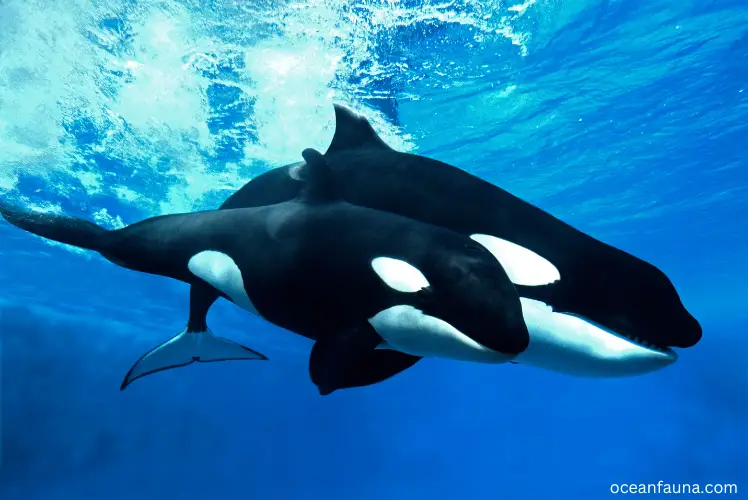
On the other hand, Orcas have a more complex relationship with humans. Some populations have a history of interactions with indigenous communities, often featured in mythology and art. In the modern context, they have been captured for display in marine parks, a practice fraught with controversy.
Like blue whales, orcas are also popular subjects for whale-watching tours, and some populations have been studied extensively, leading to significant advances in our understanding of cetacean behavior and ecology. ~ Source
| Species | Interaction With Humans |
| Blue Whale | Historical whaling, whale-watching, scientific research |
| Orca | Cultural significance, capture for marine parks, whale-watching, scientific research |
10. Threats and Conservation Status
Blue whales and orcas face several threats, primarily due to human activities, impacting their conservation status.
Blue whale
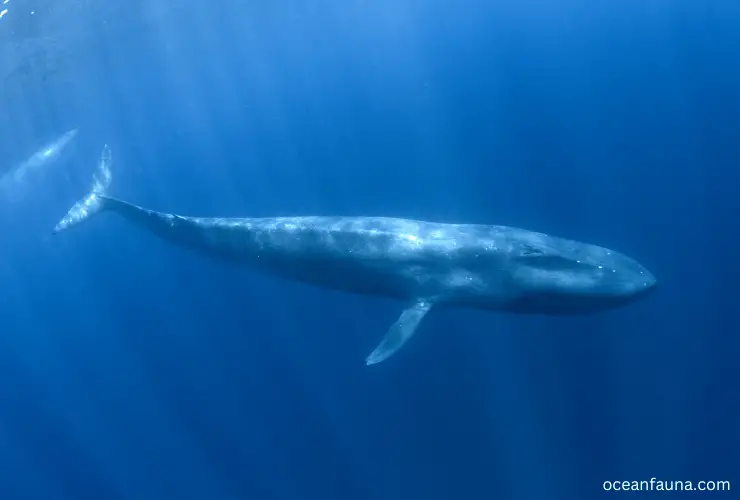
Blue whales were laboriously hunted in the 1900s, causing a significant decline in their population, as documented in the Encyclopedia of Biodiversity (Second Edition).
While commercial hunting has been banned, they still face threats from ship strikes, entanglement in fishing gear, climate change (which impacts their food sources), and noise pollution.
The IUCN Red List has listed blue whales as an ‘Endangered’ species.
Orca
Orcas face a variety of threats, including pollution (such as PCBs and other contaminants), reduced prey availability (due to overfishing), noise pollution, and habitat disturbance. In some regions, orcas also face threats from capture for marine parks. ~ Source
The conservation status of orcas is listed as Data Deficient by the IUCN.
| Species | Threats | Conservation Status |
| Blue Whale | Ship strikes, entanglement, climate change, noise pollution | Endangered (IUCN) |
| Orca | Pollution, prey depletion, noise pollution, habitat disturbance, capture for marine parks | Data Deficient. |
1. Blue Whale vs Orca: Who Would Win the Battle
Blue whales are the largest creatures on the planet, with lengths reaching 100 feet and weight of roughly 200 tons. Conversely, an average orca grows to about 26 feet long and weighs almost 6 tons.
While size is certainly a significant factor, it does not guarantee a victory. Orcas are known for their intelligence, teamwork, and hunting strategies. In the wild, orcas have been seen preying on larger animals, as large as blue whales.
In a rare, documented case off the coast of Australia, a blue whale was reported to have been devoured by a super pod of 75 orcas. The orcas, one after another, took their turns to bite and ram into the blue whale.
Despite the blue whale’s desperate attempts to escape, the orcas’ persistent chase and strategic attack left it with no chance of survival and it died.
Thus, when it comes to a showdown between a large pod of orcas and a blue whale, the sheer numbers tip the scales in favor of the orcas. However, if the scenario were to shift to a one-on-one encounter, the immense size of the blue whale could potentially give it an upper hand over a single orca.
FAQs
What are other names for orcas, killer whales?
A: Orcas are also referred to as ‘wolves of the Sea.’
How many blue whales are left in the world?
A: On average, around 25,000 blue whales are left in the world.
Wrapping Up
So, are blue whales and orcas the same? Far from it. Although both blue whales and orcas are cetaceans, they exhibit significant differences.
Blue whales, the gentle giants of the ocean, primarily rely on massive krill swarms for sustenance. They prefer the solitude of the open seas or the company of a small group. Conversely, orcas, the highly intelligent predators of the ocean, boast a diverse diet and complex social structures within their pods.
Despite these contrasts, both blue whales and orcas offer an exciting view into the complexity of life beneath the waves, each contributing unique pages to the broader story of marine life.
We hope this blog has enhanced your understanding and admiration of our oceans’ glorious biodiversity. Don’t hesitate to dive back in for more informative comparisons!


2 thoughts on “Blue Whale Vs Orca: Key Differences & Battle Winner”